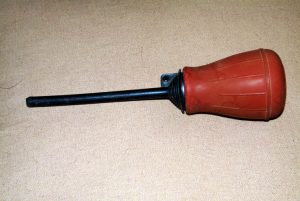A selection of useful tidbits of information for the aquarist. Readers are encouraged to send their tips to [email protected] for possible publication. For submissions that are published in Advanced Aquarist, the author will receive a $25.00 gift certificate from one of our participating advertisers.
Polyethylene siphon pumps are really handy when it comes to target-siphoning out of sumps. The squeeze siphon bulb allows you to pump water out into a container that doesn’t have to be at a lower level than the sump, and you can stop or start the flow quickly to avoid pumping out too much water when removing settled detritus.
Ken Uy, http://kensreef.tripod.com/reef2.htm
Here is a simple tip.
I am sure nobody enjoys the taste of saltwater when they are trying to start a siphon for their overflow box. Well, there is an easy solution for that. A 60-cc syringe with a blunt end has a tip that the standard aquarium airline hose will slip over. Just attach the syringe to the hose, place the hose into the overflow u-tube as detailed in the instructions that came with the overflow box, and pull the syringe. This should remove the air and start the flow of water.
Tracy Doherty, [email protected]
Many aquarists love the idea of covering the back glass of their aquarium with a “living wall” of xenia, zooanthids or similar animals. Lots of folks try to accomplish this by gluing cuttings directly on the tank glass, an experience that often ends in frustration and lost cuttings if the animals don’t quickly grow over the bond and onto the glass themselves. There is a simple solution, though. Rather then try to glue cuttings, simply position a colony of the coral you want to colonize the back glass against the back glass itself. As long as some of the living animal is touching the glass and as long as it’s growing and healthy, you’ll quickly see it spread to the glass. Since most organisms will grow upwards towards the light in any case, introducing the colonization low in the tank will ensure more rapid, even development in any case.
In a similar vein, it’s possible to “carpet” an aquarium. If you have a tank you don’t wish to use a substrate with and you don’t care for the bare-bottom look, wall-to-wall carpets of green star polyps or zooanthids can make for a spectacular display. You can break up the appearance a bit by placing small, irregular rocks on the glass as well; these will be colonized by the animals, leading to a less two-dimensional look to your “carpet”. Again, the easiest way to accomplish this is simple place the organism you wish to colonize the bottom glass directly on it.
Charles J DeVito
People who use skimmers and reactors with neoprene gaskets usually have a hard time separating lids etc because the gasket sticks. The way to prevent that is to dust your neoprene gaskets with starch. Your gaskets will not stick and will readily come off.
Bob Schulz
I have found that the rubber in the bulb of turkey-basters rots quite quickly when used in salt water, when target feeding. By going to a auto supply store it possible to purchase a battery filler pictured here. I have used this device as a turkey baster for several years without a problem.




0 Comments